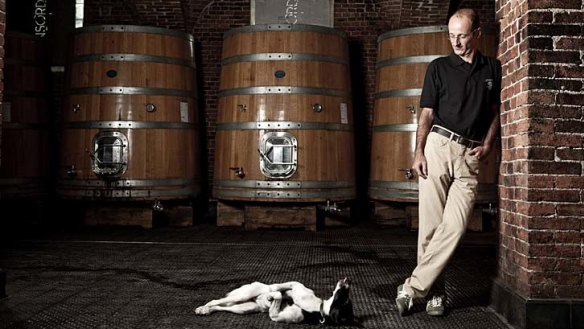The toast of Italy
What could be finer than sipping outstanding vino with great winemakers?

If you need multiple stars to get you along to a concert, A Day on the Green at Centennial Vineyards in Bowral a few years back might have done it. Diana Krall topped a bill that included Madeleine Peyroux, Melody Gardot and Katie Noonan. If you needed more than one headline act to get you along to a wine dinner, the recent Ceretto event at Buon Ricordo might have done it. This was the vinous equivalent of that drizzly but magical afternoon and evening of jazz in the southern highlands.
Topping the bill was Ceretto, one of Piedmont's great family-owned wine producers, which makes barbaresco and barolo and has wineries in both zones. Chief winemaker Alessandro Ceretto was guest of honour. We drank 11 of his wines. His Aussie assistant winemaker, Dave Fletcher, was also there. Raised in the Adelaide Hills, Fletcher made some superb nebb from the Pyrenees and Adelaide Hills before moving his young family to Italy in 2012 to take up the opportunity of a lifetime. Also in the room were Xavier Bizot, who heads up Ceretto's Aussie importer, Adelaide-based Terroir Selections.
Bizot and his wife, Lucy, make their own sparkling wine, Daosa Blanc de Blancs 2009, which was served as aperitif. Bizot's father-in-law, Brian Croser, was also there, and three of his Tapanappa wines were served. And Peter Godden, a serious technical man whose day job is at the Australian Wine Research Institute. He and his wife, Sally McGill, are Italian nebb tragics and produce one of Australia's finest nebbiolos in the Adelaide Hills, called Arrivo. We drank their 2008 vintage.
That's, gee, how many wines? Sixteen - or should that be shishteen?
Armando Percuoco's cucina was the icing on the cake, so to speak. His fettuccine al tartufovo is one of my favourite things. It went pretty well with the '08 Arrivo and Ceretto's entry-level nebb, Nebbiolo d'Alba 2010.
These two wines exemplified the gulf in style that exists between Australian and Piedmontese nebb, superb though each was in its own right. The Arrivo smelt ever-so-slightly minty, together with gorgeous red fruit and rose-petal fragrances. It was almost unbelievably soft in the mouth, with refined texture and gossamer tannins.
Ceretto was generous in his public praise for this wine. You could tell he really loved it and enjoyed its Australian-ness. After all, there would be little point us producing Australian nebbiolo if it was indistinguishable from the Italian. Asked about the mint character, which is believed to come from eucalypt trees near the vines, Ceretto said - in highly articulate English - he regarded anything influencing the wine which came from the natural environment of the vine was a legitimate part of that wine. Amen.
His own 2010 Nebbiolo d'Alba was less fruity and more savoury, quite structured, with ample tannins that were ripe and smooth and in no way did it taste like inferior off-cuts, as some of its kind can do. It was simply a junior version of the more powerfully structured single-vineyard barolos and barbarescos that came later.
I asked Fletcher what he thought a young Australian could bring to a distinguished Italian producer such as Ceretto. He said he didn't expect to make big changes immediately, but he thought he might be able to introduce some better work practices in the cellars, and address some of the quality control issues. One of these is the laboratory: Ceretto has a good lab but outsources most of its analyses, and Fletcher believes he can bring these in-house and reduce costs while speeding up procedures. The spoilage yeast brettanomyces is also an issue throughout the Piedmont wine industry.
Fletcher believes Australians have significantly broader experience than most Piedmontese: they travel widely, working in various countries in addition to their own and are more up-to-date with current thinking in both winemaking and viticulture.
Fletcher has already produced his first barbaresco under his eponymous label, a 2009 at $60, available now. It's very good. Perhaps they could include it next time the boys are in town and, like the Day on the Green girls, make it a four-act event.
The Ceretto wines
● Blange Langhe
Arneis 2011, $36
● Rossana Dolcetto
d'Alba 2010, $29
● Bernardina Nebbiolo d'Alba 2010, $42
● Asij Barbaresco 2008, $82
● Bricco Asili Bernadot Barbaresco 2008, $130
● Bricco Asili Barbaresco 2008, $250
● Zonchera Barolo 2008, $70
● Bricco Rocche Prapo Barolo 2008, $130
● Bricco Rocche Barolo 2008, $325
● Bricco Rocche Prapo Barolo 2005, $NA
● Moscato d'Asti 2012, $40
All of these wines were excellent examples in their stations. The most statuesque, powerful and complex are the Barbaresco cru Bricco Asili and Barolo cru Bricco Rocche, as their prices suggest. But the best value for money are without doubt the entry-level barbaresco branded Asij and barolo branded Zonchera. These are superb wines, which epitomise the two districts, the barbaresco very fine, elegant and softer in tannins; the barolo more robust but also smooth, with earth and leather aromas. 2008 is a superb vintage. Five Way Cellars, Paddington, stocks the wines.
